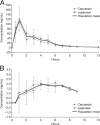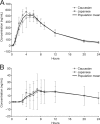Low penetration of oseltamivir and its carboxylate into cerebrospinal fluid in healthy Japanese and Caucasian volunteers
- PMID: 18676886
- PMCID: PMC2565879
- DOI: 10.1128/AAC.00327-08
Low penetration of oseltamivir and its carboxylate into cerebrospinal fluid in healthy Japanese and Caucasian volunteers
Abstract
Oseltamivir is a potent, well-tolerated antiviral for the treatment and prophylaxis of influenza. Although no relationship with treatment could be demonstrated, recent reports of abnormal behavior in young individuals with influenza who were receiving oseltamivir have generated renewed interest in the central nervous system (CNS) tolerability of oseltamivir. This single-center, open-label study explored the pharmacokinetics of oseltamivir and oseltamivir carboxylate (OC) in the plasma and cerebrospinal fluid (CSF) of healthy adult volunteers over a 24-hour interval to determine the CNS penetration of both these compounds. Four Japanese and four Caucasian males were enrolled in the study. Oseltamivir and OC concentrations in CSF were low (mean of observed maximum concentrations [C(max)], 2.4 ng/ml [oseltamivir] and 19.0 ng/ml [OC]) versus those in plasma (mean C(max), 115 ng/ml [oseltamivir] and 544 ng/ml [OC]), with corresponding C(max) CSF/plasma ratios of 2.1% (oseltamivir) and 3.5% (OC). Overall exposure to oseltamivir and OC in CSF was also comparatively low versus that in plasma (mean area under the concentration-time curve CSF/plasma ratio, 2.4% [oseltamivir] and 2.9% [OC]). No gross differences in the pharmacokinetics of oseltamivir or OC were observed between the Japanese and Caucasian subjects. Oseltamivir was well tolerated. This demonstrates that the CNS penetration of oseltamivir and OC is low in Japanese and Caucasian adults. Emerging data support the idea that oseltamivir and OC have limited potential to induce or exacerbate CNS adverse events in individuals with influenza. A disease- rather than drug-related effect appears likely.
Figures


Similar articles
-
Absence of central nervous system and hypothermic effects after single oral administration of high doses of oseltamivir in the rat.Basic Clin Pharmacol Toxicol. 2012 Jul;111(1):50-7. doi: 10.1111/j.1742-7843.2012.00861.x. Epub 2012 Mar 8. Basic Clin Pharmacol Toxicol. 2012. PMID: 22309322
-
Assessment of neuropsychiatric adverse events in influenza patients treated with oseltamivir: a comprehensive review.Drug Saf. 2008;31(12):1097-114. doi: 10.2165/0002018-200831120-00006. Drug Saf. 2008. PMID: 19026027 Review.
-
Pharmacokinetics of high-dose oseltamivir in healthy volunteers.Antimicrob Agents Chemother. 2009 Mar;53(3):945-52. doi: 10.1128/AAC.00588-08. Epub 2008 Dec 22. Antimicrob Agents Chemother. 2009. PMID: 19104028 Free PMC article.
-
Similarity in pharmacokinetics of oseltamivir and oseltamivir carboxylate in Japanese and Caucasian subjects.J Clin Pharmacol. 2007 Jun;47(6):689-96. doi: 10.1177/0091270007299761. Epub 2007 Apr 24. J Clin Pharmacol. 2007. PMID: 17456583 Clinical Trial.
-
Oseltamivir in neonates, infants and young children: a focus on clinical pharmacology.Infect Disord Drug Targets. 2013 Feb;13(1):15-24. doi: 10.2174/18715265112129990004. Infect Disord Drug Targets. 2013. PMID: 23675923 Review.
Cited by
-
Oseltamivir in seasonal influenza: cumulative experience in low- and high-risk patients.J Antimicrob Chemother. 2010 Apr;65 Suppl 2(Suppl 2):ii11-ii24. doi: 10.1093/jac/dkq012. J Antimicrob Chemother. 2010. PMID: 20215131 Free PMC article. Review.
-
A Critical Role for Immune System Response in Mediating Anti-influenza Drug Synergies Assessed by Mechanistic Modeling.CPT Pharmacometrics Syst Pharmacol. 2014 Sep 10;3(9):e135. doi: 10.1038/psp.2014.32. CPT Pharmacometrics Syst Pharmacol. 2014. PMID: 25207611 Free PMC article.
-
Pharmacokinetic Modeling and Monte Carlo Simulation to Predict Interindividual Variability in Human Exposure to Oseltamivir and Its Active Metabolite, Ro 64-0802.AAPS J. 2017 Jan;19(1):286-297. doi: 10.1208/s12248-016-9992-0. Epub 2016 Oct 31. AAPS J. 2017. PMID: 27800573
-
Oseltamivir in seasonal, avian H5N1 and pandemic 2009 A/H1N1 influenza: pharmacokinetic and pharmacodynamic characteristics.Clin Pharmacokinet. 2010 Nov;49(11):741-65. doi: 10.2165/11534730-000000000-00000. Clin Pharmacokinet. 2010. PMID: 20923248 Review.
-
Simultaneously Predicting the Pharmacokinetics of CES1-Metabolized Drugs and Their Metabolites Using Physiologically Based Pharmacokinetic Model in Cirrhosis Subjects.Pharmaceutics. 2024 Feb 5;16(2):234. doi: 10.3390/pharmaceutics16020234. Pharmaceutics. 2024. PMID: 38399287 Free PMC article.
References
-
- Bleasby, K., L. A. Hall, J. L. Perry, H. W. Mohrenweiser, and J. B. Pritchard. 2005. Functional consequences of single nucleotide polymorphisms in the human organic anion transporter hOAT1 (SLC22A6). J. Pharmacol. Exp. Ther. 314:923-931. - PubMed
-
- Ereshefsky, L., S. S. Jhee, M. T. Leibowitz, S. Moran, M. Yen, and L. Gertsik. 2006. Demonstrating proof of principle and finding the right dose: the role of CSF ‘Dynabridging’ studies. Abstr. 25th Bienn. Congr. Coll. Int. Neuro-Psychopharmacol. (CINP), Chicago, IL.
-
- Fujita, T., C. Brown, E. J. Carlson, T. Taylor, M. de la Cruz, S. J. Johns, D. Stryke, M. Kawamoto, K. Fujita, R. Castro, C. W. Chen, E. T. Lin, C. M. Brett, E. G. Burchard, T. E. Ferrin, C. C. Huang, M. K. Leabman, and K. M. Giacomini. 2005. Functional analysis of polymorphisms in the organic anion transporter, SLC22A6 (OAT1). Pharmacogenet. Genomics 15:201-209. - PubMed
-
- Fuke, C., Y. Ihama, and T. Miyazaki. 2008. Analysis of oseltamivir active metabolite, oseltamivir carboxylate, in biological materials by HPLC-UV in a case of death following ingestion of Tamiflu. J. Leg. Med. (Tokyo) 10:83-87. - PubMed
Publication types
MeSH terms
Substances
LinkOut - more resources
Full Text Sources

